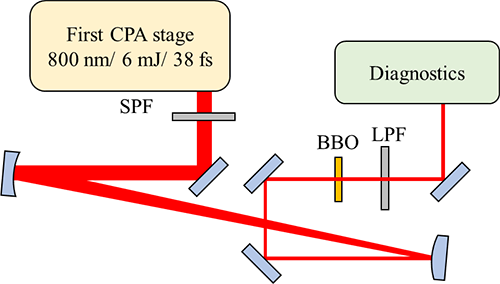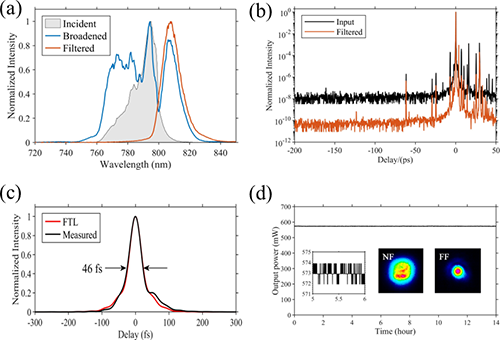High-contrast Femtosecond Pulses Generated by Cascaded Second-order Nonlinear Processes in a Single Crystal
With the development of ultrashort and ultra-intense laser technology, people have been able to generate up to 10 PW peak power in tens of femtoseconds of optical pulses, with the focused light intensity exceeding 1023 W/cm2. Such light fields create extreme physical conditions with ultra-high energy density, ultra-high temperature, ultra-strong electric field, ultra-strong magnetic field and ultrafast time scale in a laboratory, and has important application value in laser acceleration, laser fusion, plasma physics, materials science, attosecond science and other fields. However, for femtosecond pulses with pre-pulses and spontaneous radiationbackground, the increase of light intensity leads to the increase of the corresponding noise. When the noise intensity exceeds 1011 W/cm2, the generated pre-ionization and other effects will severely disturb the interaction effect between the main pulse and matter, hence the ratio of the main pulse to the noise intensity, namely the temporal contrast, has to be improved, which is one of the important research items of ultrafast and ultra-intense laser pulses.
Wei Zhiyi's research team in the Institute of Physics under the Chinese Academy of Sciences/Beijing National Research Center for Condensed Matter Physics has been committed to the research of femtosecond laser amplification and temporal contrast improvement for many years. As early as 2010, they proposed a non-collinear femtosecond optical parametric amplification method to generate high-contrast seed pulses, which improved the contrast to the order of 10-11 [Opt. Lett. 35, 3096 (2010)] and applied this method to femtosecond ultra-intense laser systems, and successfully developed femtosecond ultra-intense lasers with a contrast of the order of 10-10 and a peak power of 1.16 PW. Not only did the problem of contrast be effectively solved, but the highest peak power at the time of such researches was achieved [Opt. Lett. 36, 3194 (2011)].
With the support of China's Major Infrastructure Construction Program during the "12th Five-Year Plan" period, in recent years, the research team has undertaken part of the work for the ultrafast light field system in the Synergetic Extreme Condition User Facility (SECUF) in Huairou District, Beijing. In the research and construction of the femtosecond laser ultrafast experiment subsystem (XD1), Dr. Wang Xianzhi, a postdoctoral researcher of the team, proposed a new scheme to improve the contrast of femtosecond amplified lasers by cascading two second-order nonlinear processes in a single nonlinear crystal as well as by spectral filtering, through close cooperation with Prof. Wang Zhaohua (in charge of the subsystem) and Prof. Wei Zhiyi (co-advisor). Thus, highly stable and high-contrast femtosecond laser pulses with pulse energies of hundreds of microjoules are directly generated using very simple structures. The experimentscheme is shown in Fig. 1. The output by the previous-stage femtosecond laser amplifier is spectrally shaped by the first filter and then incident into the BBO crystal to perform second harmonic generation first, and then the short-wave part of the frequency doubled light and the fundamental frequency light generate idler frequency light with longer wavelength via DFG. The newly generated idler frequency light is selected by the second filter. At 3 mJ incident energy, an output of 570 μJ per pulse with the main pulse contrast up to 10-11 is obtained, and the RMS power jitter within 14 hours is as low as 0.076%. By cascading two second-order nonlinear processes, the contrast enhancement effect equivalent to the third-order nonlinear effect is obtained at a lower incident light intensity, without the need for a vacuum system, and the two processes occur in the same crystal without delay control. Therefore, hundreds of microjoules of highly stable and high-contrast femtosecond pulses can be directly generated in the air. This greatly simplifies the structure of contrast enhancement unit and has large application potential in the research of femtosecond ultra-intense laser devices.
The results are published in the latest issue of Optics Letters [Vol. 47, No. 19, pp. 4981-4984 (2022)]. This is also the team's latest innovation in the improvement of femtosecond laser temporal contrast, and provides important support for the construction of femtosecond laser ultrafast experiment subsystem in SECUF in Huairou District. The previous achievements include Chin. Phys. Lett, 31, 014207(2014), Chin. Phys. Lett, 34, 024205(2017), and Chin. Phys. Lett, 38, 074202(2021).
This work has also been supported by the Strategic Priority Research Program of the Chinese Academy of Sciences and the National Natural Science Foundation of China.
Link to online article: https://doi.org/10.1364/OL.465717

Fig. 1 System structure. SPF: short-pass filter. LPF: Long-pass filter.

Fig. 2. Parameters of the resulting high-contrast femtosecond laser pulse: (a) spectra at various locations; (b) temporal contrast of the incident pulse to the output pulse; (c) width of the output pulse; (d) power stability of the output pulse and near/far-field light spot distribution
